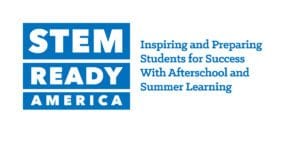
On Wednesday, March 1, new resources and research was released, highlighting how afterschool programs can provide gains in critical workforce skills and interest in STEM careers.
The evidence is clear: Students participating in afterschool programs that focus on science, technology, engineering, and math (STEM) reported increased interest in science careers and gains in important 21st century skills such as critical thinking and perseverance, which are in high demand in today’s workforce.
The key findings emerge from the Afterschool & STEM System Building Evaluation 2016, an ambitious study supported by the Charles Stewart Mott Foundation and STEM Next. The study looked at the impact of more than 160 afterschool programs, surveying nearly 1,600 youth in grades 4 through 12 across 11 states. The study is the latest in a growing body of evidence demonstrating that afterschool programs help students succeed in school, work, and life. Highlights of the findings include:
- More than 70 percent of students across all states reported positive gains in areas of science interest, science identity, science career interest and career knowledge, and 21st century skills, including perseverance and critical thinking
- 80 percent of students reported a positive gain in their science career knowledge
- 78 percent experienced a positive change in their self-reported interest in science
- 72 percent reported an increase in their perseverance and critical thinking skills
- 73 percent reported an increase in “STEM identity”—a personal belief that he/she can do well and succeed at science
 Findings from the study are included in the new resource: STEM Ready America: Inspiring and Preparing Students for Success with Afterschool and Summer Learning, a compendium of articles from 40 leading experts featured on a new website (www.stemreadyamerica.org). The site provides success stories, research, and articles on STEM learning from policymakers, educators, and business, foundation, and youth development leaders. From Executive Editor Ron Ottinger of STEM Next, this powerful collection of articles portrays the state of the field of STEM learning— especially in the time and space beyond school.
Findings from the study are included in the new resource: STEM Ready America: Inspiring and Preparing Students for Success with Afterschool and Summer Learning, a compendium of articles from 40 leading experts featured on a new website (www.stemreadyamerica.org). The site provides success stories, research, and articles on STEM learning from policymakers, educators, and business, foundation, and youth development leaders. From Executive Editor Ron Ottinger of STEM Next, this powerful collection of articles portrays the state of the field of STEM learning— especially in the time and space beyond school.
We have created a toolkit to help you spread the news to your networks and partners. The toolkit contains sample social media language, graphics, email language and more! Here is how you can help spread the word:
- Share the graphics on Twitter and Facebook.
- Join the online conversation at #AfterschoolSTEM
- E-mail your networks and let them know about the research

